
Pedicularis dasyantha, the woolly lousewort or arctic hairy lousewort, is a plant native to the high arctic areas of Svalbard, Novaya Zemlya and the bordering mainland, and the western Taymyr Peninsula. In Svalbard it is restricted to the main island, Spitsbergen.

Hibiscus laevis, the halberd-leaf rosemallow, is a herbaceous perennial flower native to central and eastern North America. Their showy, creamy-white or pink flowers are large, up to 15 centimetres (6 in) across, and are hard to miss. These flowers require exposure to sunlight to open up properly, and then last only a single day.

Astragalus alpinus is a species of flowering plant in the legume family known by the common name alpine milkvetch. It has a circumpolar distribution, occurring throughout the upper latitudes of the Northern Hemisphere.

Pedicularis is a genus of perennial green root parasite plants currently placed in the family Orobanchaceae.

Lamium maculatum is a species of flowering plant in the family Lamiaceae, native throughout Europe and temperate Asia.

Pedicularis groenlandica is a showy flowering plant in the family Orobanchaceae which is known by the common names elephant's head, elephant-head lousewort and butterfly tongue.

Mimulus ringens is a species of monkeyflower known by the common names Allegheny monkeyflower and square-stemmed monkeyflower.
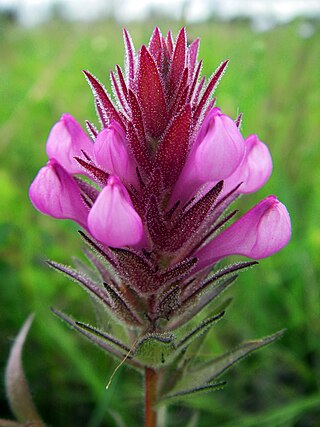
Orthocarpus bracteosus is a species of flowering plant in the broomrape family known by the common name rosy owl's-clover. It is native to western North America from British Columbia to northern California, where it grows in moist mountain habitat, such as meadows.

Pedicularis centranthera is a species of flowering plant in the family Orobanchaceae known by the common names dwarf lousewort and Great Basin lousewort. It is native to the western United States from eastern Oregon and California to Colorado and New Mexico, where it grows in sagebrush and other basin and plateau habitat. It is a perennial herb producing several short stems a few centimeters tall from a basal caudex. The leaves are up to 20 centimeters long, lance-shaped and divided into many overlapping toothed, wrinkled, or fringed lobes. The inflorescence is a short raceme bearing many long, protruding, club-shaped flowers. Each flower may exceed 4 centimeters in length and is white or pale purple with dark purple tips on the wide ends of its upper and lower lips. The sepals of the flowers are shorter and hairy. The fruit is a capsule around centimeter long containing seeds with netlike surfaces.

Pedicularis contorta is a species of flowering plant in the family Orobanchaceae known by the common names coiled lousewort and curved-beak lousewort. It is native to western North America, including southwestern Canada and the northwestern United States, where it grows in moist mountainous habitat, such as bogs, shady forests, and meadows. It is a perennial herb producing one or more stems up to 40 centimetres (16 in) tall from a caudex. The leaves are up to 18 centimetres (7.1 in) long, lance-shaped to oblong, and divided into many linear lobes which may be toothed or smooth-edged. The inflorescence is a raceme of flowers occupying the top of the stem. Each flower is a centimeter long or slightly longer, white to yellowish in color, and divided into a coiled or curved beak-like upper lip and a flat, three-lobed lower lip. The fruit is a capsule up to a centimeter long containing seeds with netted surfaces.
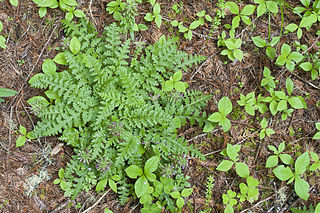
Pedicularis dudleyi is a rare species of flowering plant in the family Orobanchaceae known by the common name Dudley's lousewort. It is endemic to central California, where it is known from about ten scattered occurrences along the coast and in the coastal mountain ranges. It has been found in three locations along the Central California coast. The species was named for 19th-century Stanford University botanist William Dudley.
Pedicularis howellii is an uncommon species of flowering plant in the family Orobanchaceae known by the common name Howell's lousewort. It is endemic to the Siskiyou Mountains of the Klamath Range in southern Oregon and northern California, where it grows on the edges of coniferous forests. This is a perennial herb producing one or more stems up to 45 centimetres (18 in) tall from a long caudex. The leaves are up to 20 centimetres (8 in) long, lance-shaped, and divided into many toothed oval lobes; those higher on the stem may be unlobed. The basal leaves fall away early. The inflorescence is a small raceme of flowers occupying the top of the stem. Each white to light purple flower is up to one centimetre long and is sickle-shaped, with a curved beak-like upper lip and a three-lobed lower lip which may be tucked into the hairy mass of sepals. The plant is pollinated by bumblebees including Bombus mixtus. Between the flowers are hairy to woolly triangular bracts. The fruit is a capsule just under a centimeter long containing seeds with netted surfaces.
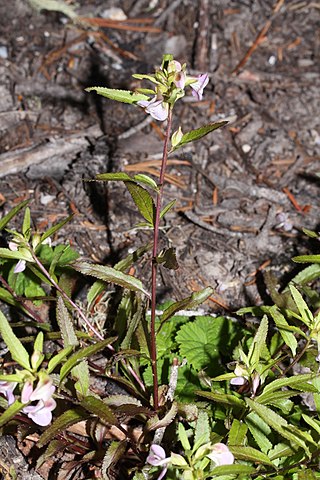
Pedicularis racemosa is a species of flowering plant in the family Orobanchaceae known by the common names sickletop lousewort and leafy lousewort. It is native to western North America, where it grows in coniferous forests. This is a perennial herb producing several stems up to 80 centimetres (31 in) tall, greenish to dark red in color. The leaves are up to 10 centimetres (4 in) long, linear in shape and lined with teeth. The inflorescence is a small raceme of flowers occupying the top of the stem. Each white to light purple or yellow flower is up to 1.6 centimetres long and is divided into a curved or coiled beak-like upper lip and a wide three-lobed lower lip. The fruit is a capsule over a centimeter in length containing smooth seeds.
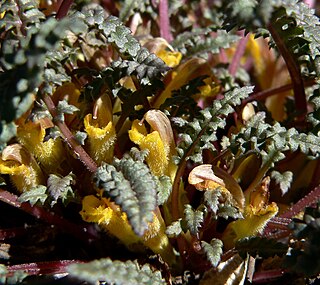
Pedicularis semibarbata, known by the common name pinewoods lousewort, is a species of flowering plant in the family Orobanchaceae.
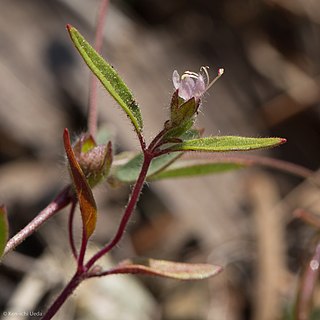
Trichostema simulatum is a species of flowering plant in the mint family known by the common name Siskiyou bluecurls.
Castilleja kerryana is a species of flowering plant in the family Orobanchaceae. It is commonly known as Kerry's Indian paintbrush or Kerry’spaintbrush. It was formally described in 2013 and so far it is known only from a small population in the state of Montana, in the Northwestern United States.
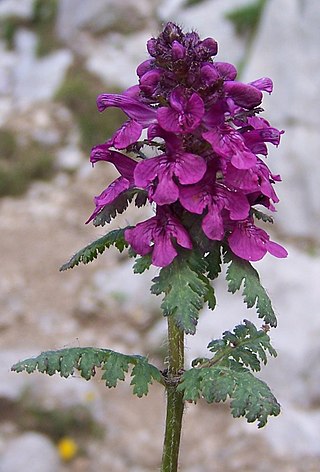
Pedicularis verticillata, the whorled lousewort, is a species of flowering plant in the family Orobanchaceae which can be found in Alaska, North-Western Canada, and everywhere in China at the elevation of 2,100–4,400 metres (6,900–14,400 ft). Its native habitats include moist meadows and lakeshores.

Pedicularis lanata is a species of flowering plant in the family Orobanchaceae. It is native to Canada and Alaska. Its common names include woolly lousewort and bumble-bee flower.
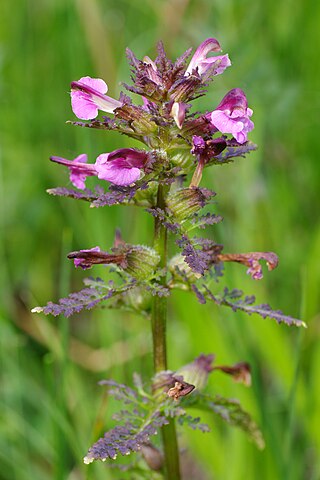
Pedicularis palustris, commonly known as marsh lousewort or red rattle, is a plant species in the family Orobanchaceae. It is native to central and northern Europe and Asia where it grows in wetlands and boggy habitats. The International Union for Conservation of Nature has assessed its conservation status as being of least concern.
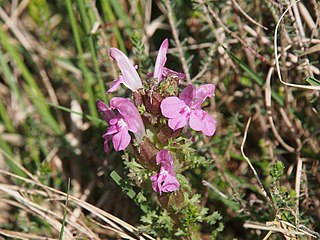
Pedicularis sylvatica, commonly known as common lousewort, is a plant species in the genus Pedicularis. It is native to central and northern Europe where it grows on moist acidic soils, moorland, grassy heathland and the drier parts of marshes.


















